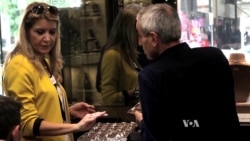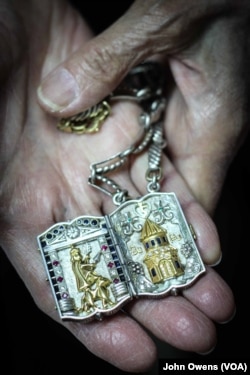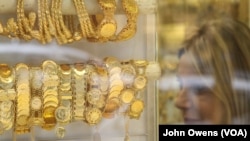It is a craft that survived the exodus of a people, but the fight is now on to prevent a once-thriving jewelry industry in Beirut’s "Little Armenia" from disappearing.
The bustling streets of Bourj Hammoud have long been renowned across the Middle East for their jewelers.
It is a reputation that stands testament to the skills and traditions of the Armenian community, which established itself in the district after being driven from what is modern-day Turkey in what some describe as an act of genocide that started in 1915.
Yet in the past decade, the ateliers that once housed world-renowned masters of their trade have been shutting down.
Going bankrupt
“The workshops are decreasing day by day. I’m hearing they’re going bankrupt,” explained jeweler Sarkis Barsoumian.
“We need to find something new, and it’s difficult to see much positive when it comes to working in Lebanon," Barsoumian said.
Like many others in Bourj Hammoud, Barsoumian’s company, named Pegor Jewelry, has been hit by events both national and international.
Business took a hit following the assassination of former Lebanese Prime Minister Rafik Hariri in 2005 and never truly recovered as the instability that followed drove away tourists and put off buyers from the Gulf.
Meanwhile, a global hike in gold prices was compounded by the entry of new international players like China and India into the market.
But for Barsoumian, there is another element that cannot be ignored.
“Many people have forgotten the skills and the expertise of those before them,” he said. "They followed the money.”
Essential craft
It is this loss that a new project is trying to address, while also encouraging Bourj Hammoud’s dwindling ateliers to look to the future.
“This is very much known to be an essential craft to the Armenian community,” claimed Sarine Hagopian.
“But through the last 20 years as factories have closed down and people, including masters, have left the business, the know-how has not been transmitted," she said.
Hagopian, who estimates that 500 ateliers remain in Bourj Hammoud, is working with local community center Badguer as part of a United Nations-backed scheme to help try to revitalize the sector.
The work will include sessions covering everything from marketing to 3-D printing, with experts in design and manufacturing from around the world – including Armenia – offering advice and tips.
“There is a lot to be inspired from in Armenian culture,” she added.
Lack of creativity
One of those welcoming the project is 84-year-old Hagop Hamamjian who started his career in jewelry at age 13.
Hamamjian explained the profound influence that Armenian masters arriving from Istanbul in the 1940s and '50s had on the local industry.
“They were creative and brought new ideas. Their presence here was a push and an incentive for people like me, ” he said, recalling a bustling four-floor souk in the heart of Beirut packed with artisans and those involved with the jewelry trade.
With the souk destroyed as the city was torn apart by a 15-year civil war that started in 1975, most Armenian jewelers like Hamamjian rebuilt his business from the ashes in Bourj Hammoud, which was already the center of the Armenian community and relatively safe.
But while Hamamjian looked up to and learned from masters craftsmen as a child, he explained that the numbers of those able to pass on the old ways had dwindled dramatically.
“The old generation worked to establish themselves, but now we are suffering from a real lack of creativity,” he told VOA
“You can count the number of masters here still in business on one hand, so it’s obvious we need projects like this.”
The new generation
Not everyone has been so enthusiastic.
With many of the younger Armenians stepping away from the jewelry trade of their ancestors in search of more secure employment, a number of artisans who had given up hope remain difficult to convince, Hagopian said.
But, there are some exceptions.
Nineteen-year-old Khajag Barsoumian has big plans for Pegor Jewelry, the business started by his father, Sarkis, and uncle Ouhannes.
Pushing for new lines and using social media to market the firm more effectively online, Khajag Barsoumian said he has drawn inspiration from the training sessions, and the idea of working more closely with other Bourj Hammoud jewelers.
“It’s about supporting one another, whether financially or morally, to face the big battle we have with the outside world in terms of surviving," the 19-year-old Barsoumian said.
And while keen to look to the future – he is developing a new line aimed at teenagers and hopes to target the European market – Khajag Barsoumian is also aware of the importance of not losing the skills handed down from one generation to the next.
"Through our course of history, jewelry has played a big role in Armenian culture – it’s like a promise from our heritage,” he told VOA.
“It’s our duty to continue this promise," Khajag Barsoumian said.
PHOTO GALLERY: Beirut's 'Little Armenia,' the Bourj Hammoud

















